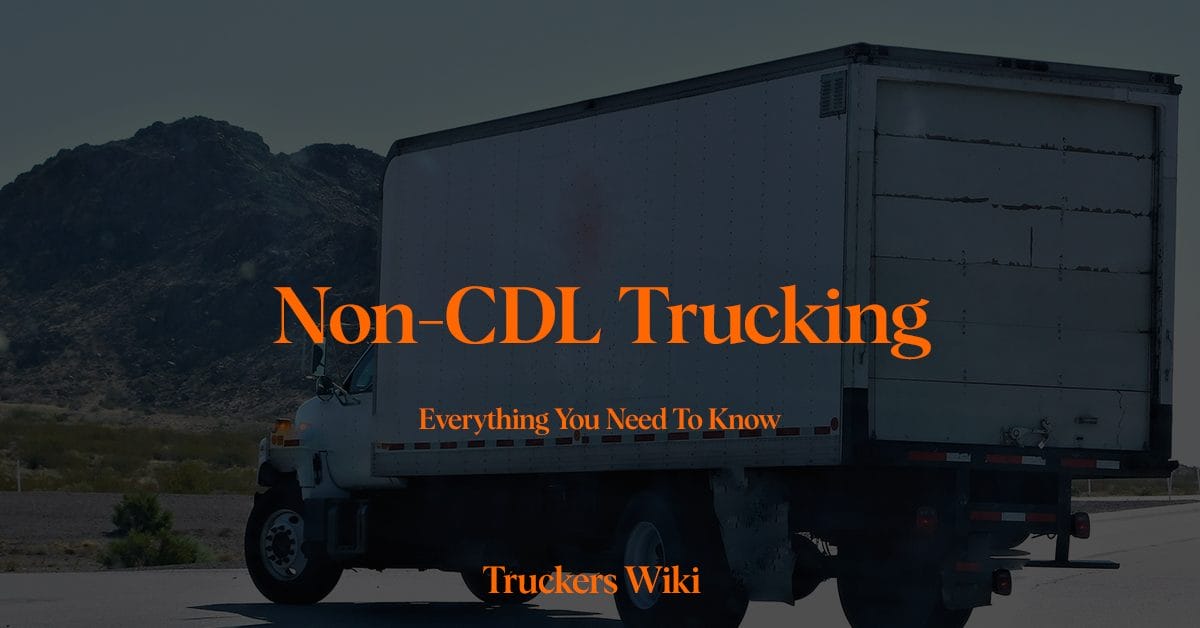
Table of Contents
What is Non-CDL Trucking
Non-CDL trucking involves operating commercial vehicles that do not require a CDL. These vehicles typically include smaller trucks such as box trucks, vans, and specialized vehicles used for business purposes, often characterized by a Gross Vehicle Weight Rating (GVWR) of less than 26,001 pounds.
Non-CDL trucking is an important niche on its own, especially in local deliveries, small-scale logistics, and specialized transport services.
Non-CDL stands for non Commercial Driver’s License.
Check out the Non-CDL category here.
NON-CDL REQUIREMENTS
Licensing and Regulations
While a CDL is not required, non-CDL truckers still need a standard driver’s license, class D, and may need specific endorsements based on their vehicle and cargo type. Understanding and complying with state-specific regulations and federal guidelines is crucial for legal and safe operation.
Vehicle Weight
Restrictions
One of the key factors in non-CDL trucking is the Gross Vehicle Weight Rating (GVWR). Non-CDL vehicles typically have a GVWR of less than 26,001 pounds. It’s essential for drivers to understand and adhere to these weight limits to avoid the need for a CDL.
State-Specific Regulations
While the federal government sets general guidelines, states may have additional requirements for non-CDL drivers.
It’s important to check with local DMV offices for specific rules and regulations in your state.
Insurance and Compliance
Proper insurance coverage is vital in non-CDL trucking, both for the vehicle and the cargo. Drivers and business owners need to understand their insurance requirements and ensure they have adequate coverage to protect against liabilities.
Learn more about Insurance here.
Types of Non-CDL Vehicles
The spectrum of non-CDL vehicles is diverse, including cargo vans, box trucks, small flatbeds, and larger passenger vehicles. Each vehicle type serves different needs, from last-mile delivery services to moving and transportation of specific goods. Another very popular non CDL niche is hotshot trucking.
Familiarity with various vehicle types and their capabilities is essential if you are considering a career in non-CDL trucking.
Most common vehicles in this niche are:
Box Trucks
Box trucks that are below the required weight or weight rating for a CDL, typically looking at box trucks that are 26 feet long or shorter. Box trucks are widely used in moving and delivery services, especially for larger items or bulk goods that require covered transportation.
Learn about Box Trucks here.
Pickup Trucks
These usually have Gross Vehicle Weight Ratings (GVWRs) of less than 10,000 lbs, with curb weights ranging from 6,300 lbs. to 7,000 lbs. Pickup trucks are versatile and can be used for a variety of tasks, including hauling and towing.
Cargo Vans
The GVWRs for cargo vans can vary. For example, a 2022 Ford Transit has a GVWR of 11,000 lbs, which allows for a payload of 3,060 to 5,110 lbs depending on the configuration. Cargo vans are ideal for deliveries and transporting goods in urban or suburban areas.
Learn about Cargo Vans here.
Passenger Vans
These are vans that transport less than 16 passengers, including the driver. They typically have a GVWR of around 10,000 or 11,000 lbs. Passenger vans are commonly used for small-scale transportation services like shuttle services, school transportation, or tour groups.
Job Opportunities and Career Paths
Non-CDL trucking offers a variety of job opportunities. Drivers can work with courier companies, e-commerce delivery services, hotshots or even start their own small-scale logistics businesses. There’s also potential for career progression, with some drivers using their experience in non-CDL trucking as a stepping stone to obtain a CDL and transition into larger-scale trucking roles.
Training and Skills Development
While formal training requirements are less demanding than for CDL trucking, non-CDL truckers still benefit from training programs focusing on safe driving practices, basic vehicle maintenance, and customer service skills. Continuous learning and skill development are key to success and safety in the field.
Learn about Defensive Driving here.
Challenges and Considerations
Non-CDL trucking comes with its own set of challenges, including navigating urban traffic, managing smaller-scale logistics, and maintaining a diverse range of vehicles. Drivers must also be adept at route planning, time management, and maintaining a high level of service quality.
The Appeal of Non-CDL Trucking
Non-CDL trucking attracts a diverse group of drivers due to its accessibility and lower barriers to entry compared to CDL-required roles. The requirements for non-CDL trucking are generally less stringent, making it an appealing option for those looking to start a career in trucking without the time and financial investment of obtaining a CDL. Additionally, non-CDL trucking often involves local or regional routes, allowing drivers to maintain a more consistent work-life balance.
External Links
Guidance regarding Non CDL Holders article by FMCSA – click here.
DOT Requirements for NON CDL Drivers article by Avatar Fleet – click here.
10 Tips For Non Cdl Box Truck Business Owner Operators by Bigg Vic
Last modified: December 20, 2023

